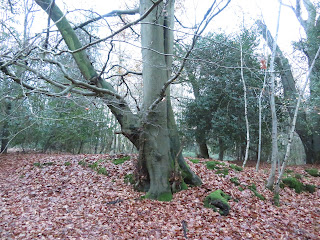I have probably said this before but I love to think about the history of the place where I am walking (even though I hated history at school.)
This area was largely Beech woodland when I first knew it and was completely flattened in the 1987 storm and is now full of (what I consider to be) young trees (obviously about 30 years old.) They are mostly birch, which is considered to be a pioneer species.
There are a few Beech remaining in the area, mostly at the edge of this old quarry. Nature conservation is a tricky subject. This area will have had different habitats and species at different times in its history: which one should we aim for now? Beech woodlands are found only on free-draining soils and are less common than other broadleaved woodlands in the area. They tend to have a specialised list of species associated with them.
The quarry though has remnants of heather and lowland heath is a particularly scarce habitat with specialists that rely on it. Perhaps clear-felling the trees should be the way forward? Certainly, where there was true heathland thirty years ago, the aim was to conserve it but there has been quite a lot of birch invasion in heathland areas. So the priority for any management should be those sites.
I have mentioned before that after the 1987 storm, there was a panic to replant woodland but it was not as successful as natural regeneration. Several tubes can still be found: it is not very clear here but the planted trees are no stronger than the natural ones. There is also the school of thought that trees with the same genes as those growing locally are more likely to be well-adapted to the local conditions, although diversity in the gene pool could be beneficial in times of disease or climate change.
There is a lot to consider but as it is National Tree Week, this is an opportunity to think about supporting sensitive tree planting or even planting one in your garden if you have room.








This comment has been removed by a blog administrator.
ReplyDeleteThis comment has been removed by a blog administrator.
ReplyDelete